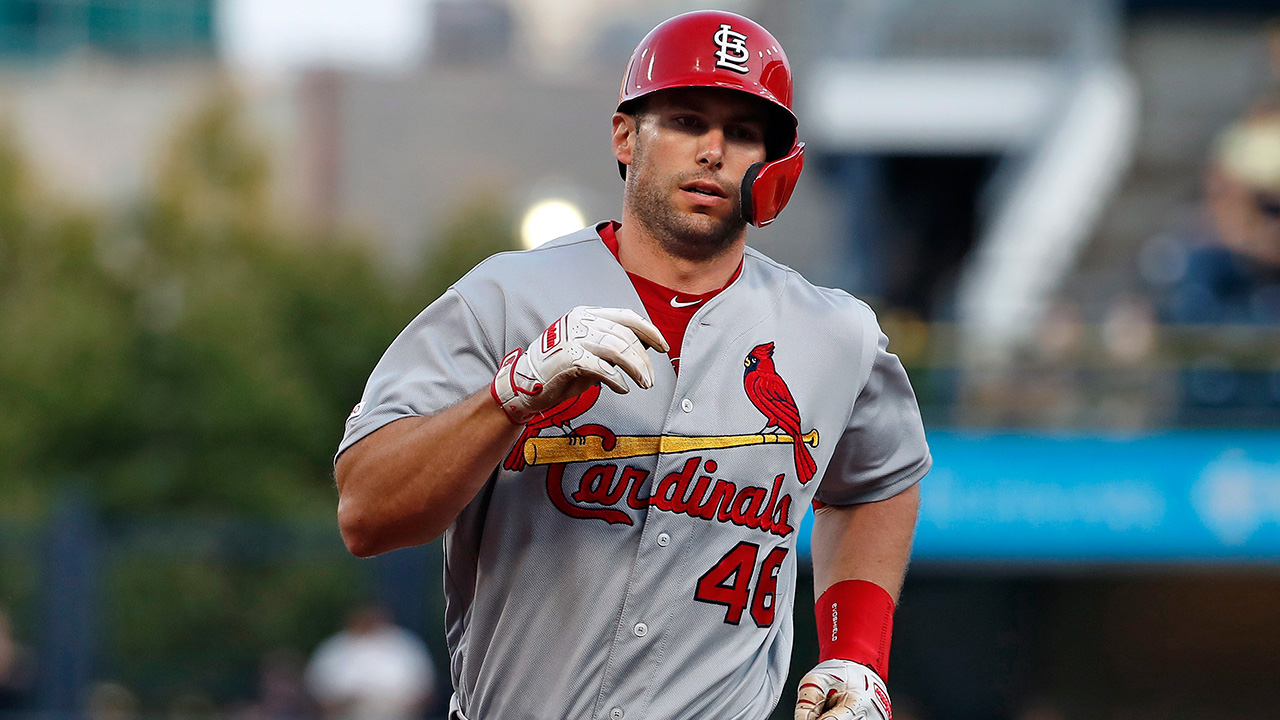DUNEDIN, Fla. — When Joe Panik walked into the Toronto Blue Jays clubhouse early Wednesday morning, he found an unfamiliar number scrawled next to his name on that day’s lineup card: 6.
Six as in shortstop. The last time he saw that? Panik was a 23-year-old at triple-A, beginning a year that would conclude with him jumping up and down on a mound after winning a World Series as the San Francisco Giants’ everyday second baseman. That was six full seasons and more than 900 games ago.
“Yeah, it’s been a while,” says Panik, now 29 and in Blue Jays camp on a minor-league deal. “The footwork’s a little different. Angle’s a little different. The ball spins off the bat a little different. But, you know, when it comes down to it — it’s still just a matter of catching and throwing.”
And why make things any more complicated than that? Panik playing shortstop during Wednesday’s rain-postponed Grapefruit League matinee — he had an opposite-field single, an RBI triple, and a perfect day in the field before the skies opened up — is as clear of an indication as the No. 2 on the back of his jersey that the Blue Jays are planning to bring him north at the end of spring training.
Of course, plenty can happen between now and opening day. But if Panik proves over the next few weeks that he can handle the position, you could see him spell Bo Bichette once every 10 games or so during the regular season, giving Toronto’s everyday shortstop and leadoff hitter a day off his feet.
“He’s not going to play 162,” Blue Jays manager Charlie Montoyo said of Bichette. “Cal Ripken’s fine. Nobody’s going to break his record.”
Essentially, Panik would assume the role Eric Sogard filled for the club last season, providing cover for both Bichette and Cavan Biggio up the middle, a high-contact left-handed bench bat for Montoyo to situationally deploy, and some veteran leadership in a young clubhouse.
What helps is that Panik actually came up as a shortstop through college and the minors, making the transition to second base as an MLB rookie because the Giants already had a first-rate player at his position in Brandon Crawford.
Panik always believed he could play multiple positions at the major-league level — it just wasn’t asked of him. This off-season, when the Blue Jays reached out to gauge Panik’s interest in signing with the club, one of the primary topics they discussed was moving around the diamond.
“That was appealing to me,” he says, “because I know I can play short and I don’t want to be pegged as only a second baseman anymore. It’ll be nice to show I can play other positions.”
Panik started the process of relearning the left side of second base this winter, drilling his footwork and hands while taking regular feeds at shortstop under the roof of Extra Innings Wappinger, the New York facility he’s spent off-seasons training at since he was in college. That daily work’s continued on backfields this spring, but there’s no simulating the way balls come off live bats and the unpredictable hops they take off worn-down infield dirt.
Panik figures the biggest thing will be getting enough in-game reps during spring to reacclimate himself to shortstop-specific plays. The ball to your backhand. The throw from deep in the hole. The unique angles you throw from as you range left and right, forward and back.
The Blue Jays are hoping to get him at least 10 Grapefruit League games at short to help the process. But coaches who have watched Panik work this spring aren’t particularly worried about it. His athleticism allows him to get to plenty of balls, and Panik’s throwing arm has looked strong during drills.
And of course he looks the part. With the increasing prevalence of shifts around baseball, today’s infielders are forced to grow accustomed to fielding from a variety of sites around the diamond.
Over the last three seasons, Panik’s seen more than 900 pitches hit in his direction. On the left in the image that follows are all the different locations in which Panik lined up on those plays, including some on the shortstop side of second, some in shallow right field, and even one behind first base. On the right is where he ended up after attempting to make the play:

“Yeah, I’m used to floating around,” he says. “It’s just a matter of getting game action over there again. That’s all it is. I know I can catch, I know I can throw. It’s just a matter of getting the reads off the bat.”
More than anything, Panik’s excited to put a challenging 12 months behind him. After serving as San Francisco’s everyday second baseman for four-and-a-half years, Panik slumped considerably over the first half of 2019, and saw the writing on the wall when the Giants acquired Scooter Gennett at the trade deadline. San Francisco was making a playoff push. Panik was hitting .232/.307/.622 at the time. Gennett brought a more successful offensive pedigree.
Less than a week later, Panik got the tap on the shoulder to go speak with his long-time manager, Bruce Bochy. He was being designated for assignment. Panik figured he might be non-tendered at the end of the season, but he wasn’t expecting to be jobless in August. Bochy described it as “one of the more difficult conversations I’ve had in my career.”
“Boch, he was the one who had faith in me as a 23-year-old kid, put me out there on a World Series team,” Panik said. “I have a lot of respect, a lot of love for him. So, that was not a fun conversation. It was emotional. It was really tough.
“It really stung at the time just because of all the friendships I had there. That’s the only organization I knew since 2011. I got drafted by them and came up with them. But, at the same time, the next day, you kind of get your mind back to it. Like, ‘All right, there’s still plenty of season left to do some work.’
Fortunately for Panik, the New York Mets were also making a playoff push and needed a second baseman to fill in for the injured Robinson Cano. Suddenly Panik was playing ball in his home state and finally experiencing success again. He had 13 hits in his first 12 games with New York and went on to bat .277/.333/.404 over a 103-plate appearance sample through the end of the season.
“It just felt really good to get back to playing my game,” he said. “I showed I can still play some baseball.”
Offensively, Panik’s numbers have been fairly pedestrian outside his remarkable, 129-OPS+, all-star 2015 campaign. He’s batted .257/.323/.371 over the four seasons since, hitting only 29 home runs in an era when the ball is leaving yards more often than ever.
But as strikeouts have risen in turn, Panik’s remained one of the toughest players in MLB to get a pitch past. His nine per cent strikeout rate over those four seasons is the second-best in baseball, as is his 90 per cent contact rate.
It’s a bit of a throwback profile. Panik’s exit velocities and hard-hit rates are consistently below average, but he puts the ball in play as much as anyone and can work deep, disciplined plate appearances, coupling an ability to foul off tough pitches with one of MLB’s lowest chase rates.
There are worse things to have at the bottom of your batting order. And Panik’s .262 BABIP last season suggests he didn’t benefit from much batted ball luck. If that number can climb closer to Panik’s career average (.287) this season, his offensive numbers are bound to improve. A move from San Francisco’s Oracle Park and New York’s Citi Field — bottom five offensive environments in 2019 — to the much more hitter-friendly Rogers Centre in Toronto ought to help that along, too.
[snippet id=3305549]
The Blue Jays also see value in adding another veteran to an extremely inexperienced clubhouse. Panik’s reputation as a quiet professional and diligent worker is well earned. And he’s seen an awful lot in his still-young career. He’s won a World Series and been an all-star. He’s featured on winning Giants teams and ones that finished last in their division. The Blue Jays are hoping his consistent approach through it all is an example its young players will be influenced by.
“Playing on good teams, you learn that it’s not about just showing up at 7:07 and playing the game. There’s a lot of preparation and a lot of work that goes in beforehand,” he said. “Numbers are great. Everybody wants to hit 50 home runs. But when it comes to September and October, it’s how you play as a team. Can you move the runner over? Can you put the ball in play? Can you make the plays in the field? Can you get the timely hit? Can you have a team at-bat?
“It’s about trying to be the same person day in and day out. Come to the field with the same attitude every day. Come and do the same work every day. Don’t ride the roller coaster. Stay as even keeled as possible. I’m not saying don’t get excited when things go great and don’t show emotion when things go bad. But it’s going to be a bumpy ride. It’s not always going to be smooth sailing. There’s going to be some turbulence along the way. It’s just about fighting through it.”
Panik knows that well after his choppy 2019. And it’s not like he’s out of the woods just yet. He still has to make Toronto’s 26-man roster, even though he’s in a great position to do so. And if he does, the Blue Jays will have to open a spot on their 40-man and pay Panik $2.85 million for the season, which are considerations that will have to be dealt with upon the end of camp.
But if Panik can make all the plays he knows he can at shortstop this spring, and contribute a few competitive plate appearances along the way, there’s a very good chance he’ll be doing the same at Rogers Centre come April. That gives him plenty to play for over the next few weeks. Not that he needs it.
“I’m always playing to prove something,” Panik says. “I know where I’m at roster-wise, competing-wise. But that’s the only thing that’s different this spring. I’m not changing anything in regard to effort level. I’m not changing anything in regard to mentality. Because I don’t take anything lightly. I never have. Mentally, physically, I’m doing the same thing I’ve always done. I don’t take anything for granted.”
[relatedlinks]








